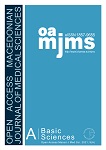Cytopathology of Saliva in COVID-19 Patients: Preliminary Study on Five Patients of COVID-19
DOI:
https://doi.org/10.3889/oamjms.2021.5572Keywords:
SARS-CoV-2, Saliva, Epithelial cells, Cell membraneAbstract
BACKGROUND: Coronavirus disease (COVID-19) is caused by a SARS-CoV-2 virus. The virus is currently known to possess single-stranded and positive-sense RNA genomes. The replication of this virus does not occur in the nucleus but in the cytoplasm of the host cell. This rapid replication can lead to impairment of host cell. Without cytoplasm, the host cell will lose its shape and may be damaged.
AIM: This study aims to find out the histopathology of exfoliated epithelial cells in saliva of COVID-19 patients.
METHODS: This was an observational study with a laboratory-based cross-sectional design. The specimens of saliva were collected from five positive people of COVID-19 and four people as negative controls of COVID-19. The determination of positive and negative infections of COVID-19 was based on the results of the real-time reverse transcription–polymerase chain reaction on nasopharyngeal swabs, oropharyngeal swabs, and sputum. The cytopathology of saliva was examined by Smear test and it was then stained by Papanicolaou method. The morphology of exfoliative epithelial cells in saliva was observed using a light microscope with magnification of ×10 and ×40. The damage of epithelial cells was observed from the integrity of the epithelial cell membrane and the shape of the damaged epithelial cells. In addition to morphologic findings, the number of cells with no nucleus was also calculated.
RESULTS: From five samples of saliva from patients of positive COVID-19, microscopically the membrane of epithelial cells was intact and the contents of the cells were scattered about. The damaged epithelial cells with nuclei were in place, which were also found, but the morphology was not normal. More cells without nuclei were frequently observed in the saliva of COVID-19 patients.
CONCLUSION: The damage to membrane and organelles of epithelial cells was found in the saliva of COVID-19 patients.
Downloads
Metrics
Plum Analytics Artifact Widget Block
References
World Health Organization. Naming the Coronavirus Disease (COVID-19) and the Virus that Causes it. Geneva: World Health Organization; 2020. Available from: https://www.who. int/emergencies/diseases/novelcoronavirus-2019/technical-guidance/naming-the-coronavirusdisease-(covid-2019)-and-the-virus-that-causes-it. [Last accessed on 2020 Mar 29].
World Health Organization. Corona Virus Disease 2019 (COVID-19). Situation Report-127. Geneva: World Health Organization; 2020. Available from: https://www.who.int/docs/ default-source/coronaviruse/situation-reports/20200526- COVID-19-sitrep-127.pdf?sfvrsn=7b6655ab_8. [Last accessed on 2020 May 26]. https://doi.org/10.26524/royal.37.10
Zhang H, Penninger JM, Li Y, Zhong N, Slutsky AS. Angiotensin-converting enzyme 2 (ACE2) as a SARS-CoV-2 receptor: Molecular mechanisms and potential therapeutic target. Intensive Care Med. 2020;46(4):586-90. https://doi.org/10.1007/s00134-020-05985-9 PMid:32125455
Roossinck MJ. Virus: An Illustrated Guide to 101 Incredible Microbes. Princeton and Oxford: Princeton University Press; 2016. https://doi.org/10.2307/j.ctvc77dwh
Liu Y, Gayle AA, Wilder-Smith A, Rocklöv J. The reproductive number of COVID-19 is higher compared to SARS coronavirus. J Travel Med. 2020;27(2):taaa021. https://doi.org/10.1093/jtm/taaa021 PMid:32052846
World Health Organization. Laboratory Testing for Coronavirus Disease 2019 (COVID-19) in Suspected Human Cases. Geneva: World Health Organization; 2020.
To KK, Tsang OT, Yip CC, Chan KH, Wu TC, Chan JM, et al. Consistent detection of 2019 novel coronavirus in saliva. Clin Infect Dis. 2020;71(15):841-3.
Navazesh M, Kumar SK. Measuring salivary flow: Challenges and opportunities. J Am Dent Assoc. 2008;139 Suppl:35S-40. PMid:18460678
Marcantoni M. Ecology of the oral cavity. In: Gastroenterology Microbiology. Fundamentals and practical guide. Negroni M Ed., Medica Panamericana. 2a ed. Buenos Aires. 2009; pp.225–231.
Kaufman E, Lamster IB. The diagnostic applications of saliva--a review. Crit Rev Oral Biol Med. 2002;13(2):197-212. PMid:12097361
Theda C, Hwang SH, Czajko A, Loke YJ, Leong P, Craig JM. Quantitation of the cellular content of saliva and buccal swab samples. Sci Rep 2018;8:6944. https://doi.org/10.1038/s41598-018-25311-0
Agol V. Cytopathic effects: Virus-modulated manifestations of innate immunity? Trends Microbiol. 2012;20(12):570-6. https://doi.org/10.1016/j.tim.2012.09.003 PMid:23072900
Collan Y, Raeste AM. Electron microscopy of exfoliated cells of human oral mucosa. Scand J Dent Res. 1978;86(5):374-85. https://doi.org/10.1111/j.1600-0722.1978.tb00640.x PMid:281758
Cuevas-Córdoba B, Santiago-García J. Saliva: A fluid of study for OMICS. OMICS. 2014;18(2):87-97. https://doi.org/10.1089/omi.2013.0064 PMid:24404837
Schafer CA, Schafer JJ, Yakob M, Lima P, Camargo P, Won DT. Saliva diagnostics: Utilizing oral fluids to determine health status. In: Ligtenberg AJ, Veerman EC, editors. Saliva: Secretion and Functions. Vol. 24. Basel: Karger Publishers; 2014. p. 88-98. https://doi.org/10.1159/000358791
Asai D, Nakashima H. Pathogenic viruses commonly present in the oral cavity and relevant antiviral compounds derived from natural products. Medicines (Basel). 2018;5(4):120. https://doi.org/10.3390/medicines5040120 PMid:30424484
Wyllie AL, Fournier J, Casanovas-Massana A, Campbell M, Tokuyama M, Vijayakumar P. Saliva is More Sensitive for SARS-CoV-2 Detection in COVID-19 Patients than Nasopharyngeal Swabs. New York: medRxiv; 2020. Available from: https:// www.medrxiv.org/content/10.1101/2020.04.16.20067835v1.full. pdf. [Last accessed on 2020 May 30]. https://doi.org/10.3410/f.737795545.793573919
Wang C, Xie J, Fei X, Zhang H, Tan Y, Zhou L. Alveolar macrophage dysfunction and cytokine storm in the pathogenesis of two severe COVID-19 patients. Lancet. 2020;57:102833. Available from: https://www.researchsquare.com/article/ rs-19346/v1. [Last accessed on 2020 May 30]. https://doi. org/10.1016/j.ebiom.2020.102833
Downloads
Published
How to Cite
License
Copyright (c) 2021 Mohammad Zulkarnain, Rostika Flora, Nyiayu Fauziah, Citra Dewi, Eny Rahmawati, Yusri Yusri, Lisa Dewi, Benny Darory, Danny Kusuma Aerosta, Krisna Murti (Author)

This work is licensed under a Creative Commons Attribution-NonCommercial 4.0 International License.
http://creativecommons.org/licenses/by-nc/4.0







